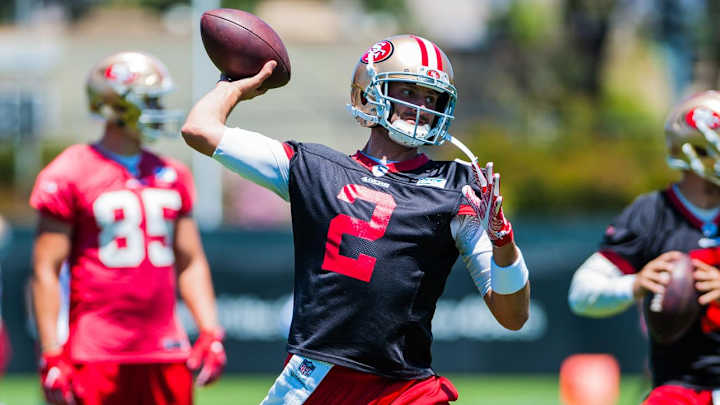San Francisco 49ers Preview: 10 Things You Need To Know

1. It was smart of Niners owner Jed York to give new head coach Kyle Shanahan and new GM John Lynch unprecedented six-year deals. Given San Fran’s front office turmoil and three head-coaching changes over the last three years (each questionable in its own way), these were the least attractive GM and coaching jobs this year. Most new head coaches get three- or four-year contracts. By committing to six years, York managed to fill the least desirable job with the market’s top candidate, Kyle Shanahan.
2. Shanahan was brilliant as the offensive coordinator in Atlanta. Obviously, it helped that he had a veteran star QB, arguably the game’s best wide receiver, two dynamic running backs and a stable O-line. Shanahan masterfully diversified his formations to create favorable mismatches, and by intertwining his receivers’ routes on each side of the field to create answers against multiple coverages. You don’t need a Julio Jones or a Devonta Freeman to do this. As long as Shanahan’s QB knows where the ball goes—and usually, journeyman placeholder Brian Hoyer does—the Niners can manufacture offense through play designs. It won’t be as pretty or lucrative as it was for Shanahan in Atlanta, but it will be more consistent than the Chip Kelly, Colin Kaepernick-led offense of a year ago.
New York Jets Preview: 10 Things You Need to Know
3. The receiving abilities of tailbacks Devonta Freeman and Tevin Coleman made Shanahan’s play designs so potent in Atlanta. They allowed the Falcons to line up in one formation and shift to another. The defense would have to tip its hand in response, and usually there wasn’t a linebacker who could cover either back. Incumbent Niners running back Carlos Hyde is a solid inside runner who can occasionally turn the corner, but he’s not a Freeman- or Coleman-like chameleon in the passing game. He had 163 yards receiving last year. If fourth-round rookie tailback Joe Williams can become a receiving threat, he’ll secure a big role.
4. There are two plus-sized offensive linemen on the right side who move well: third-year tackle Trent Brown and last year’s first-round guard Josh Garnett (a tremendous pull-blocker). Mobile right side O-line tandems are rare.
5. Pierre Garçon joined the select club of players who have earned a lucrative third contract in their NFL careers. The soon-to-be 31-year-old signed for $47.5 million over five years as a free agent. He’s worth it. Garçon is still one of the strongest in-breaking route runners in football. And his willingness as a blocker helps this outside zone running game.
6. The most fascinating question with the 49ers: Who will line up along the defensive line, and where? Most of the players, including recent Oregon first-round picks DeForest Buckner and Arik Armstead, were drafted for a 3-4. But first-time defensive coordinator Robert Saleh is installing a Seahawks Cover 3-style scheme, which features a 4-3 front. But don’t overthink this part of it. The contrast of a 3-4 versus a 4-3 gets overblown. In today’s NFL, both schemes feature similar one-gap principles. More than that, about 65% of snaps involve a nickel defense, which usually means straight 4-3 principles. This is why rookie No. 3 overall pick Solomon Thomas should play the defensive tackle role that he played 85% of the time at Stanford. Yes, at 273 pounds, Thomas would be the lightest defensive tackle in the NFL. But he can kick over to defensive end on running downs. As for those other two: Buckner, who played with better leverage in the second half of his rookie season, has the power to be an excellent nickel defensive tackle. That would leave Armstead playing wide 9, a less-than-ideal role for him but one that he at times played last season.
Cleveland Browns Preview: 10 Things You Need to Know
7. Saleh’s Seahawks-style Cover 3 is a single-high safety zone coverage where defenders drop to landmarks on the field. But here’s the thing: the rest of the league’s Seahawks-style Cover 3 defenses—Atlanta, Jacksonville and, of course, Seattle—all increased their snaps of man coverage down the stretch last year. You wonder if offenses have concocted too many ways to attack that Cover 3.
8. The Niners may not have good enough corners to play regular snaps of man-to-man. Dontae Johnson, Keith Reaser, lanky Rashard Robinson and rookie Ahkello Witherspoon are all recent mid-round picks. Typically, mid-rounders don’t suffice at the most athletically demanding position in football. Last year the Niners, who struggled often in pass defense, played a lot of two-deep coverages because the coaches didn’t trust these corners one-on-one.
9. San Francisco’s best corner, Jimmie Ward, has moved to free safety. He’ll now play centerfield. That means San Francisco’s most gifted and versatile defender, Eric Reid, will be the high-hole safety, playing a few yards behind the linebackers down in the box. Both players have toggled between multiple positions over the past two years. It will be interesting to see how they perform now at static positions.
10. I’d bet last year’s defensive coordinator, Jim O’Neil, snickered ruefully when the Niners got Alabama linebacker Reuben Foster near the end of the first round. Injuries, and the resulting deficiencies, at linebacker are what hurt this defense most in 2016.
Question? Comment? Story idea? Let us know at talkback@themmqb.com
